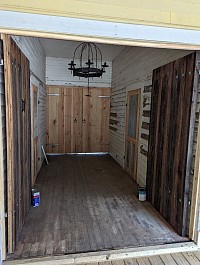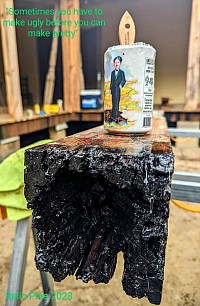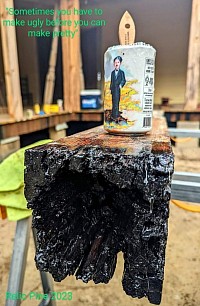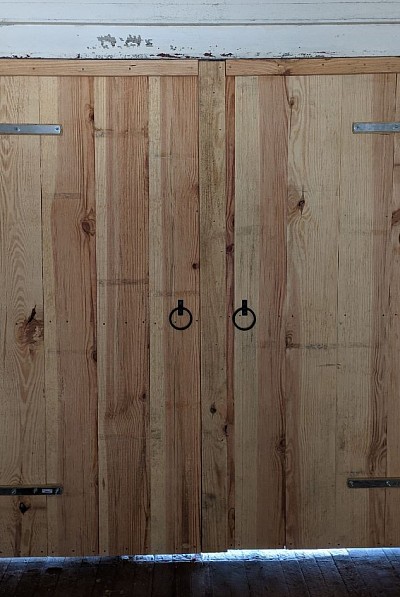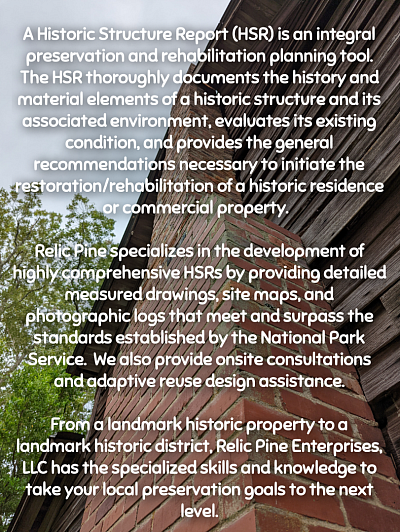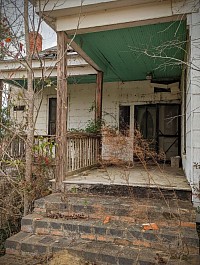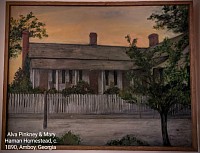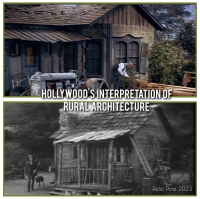Relic Pine's Rambling Blog
Scottish & Irish Homesteads on the Georgia Frontier
The Scottish and Irish immigration to North America began long before the founding of our American Republic. These hearty souls were responsible for making the first roads into the great wilderness along what originally began as game trails and Indian paths. With them they brought unique attributes of ancient Celtic culture, music, dance, religion, strong work ethic, and a propensity for innovation. There is no better example of their ingenuity than their frontier architecture. They built their homes to suit the land and climate much the same way they did in their old country.
The dog trot floor plan has it's origins in Scotland and Ireland, the surviving examples we find in Wiregrass Georgia are vernacular styles created using locally procured materials, namely old growth oak and pine, rather than stone. Starting in early 18th century Virginia, the earliest homes were constructed from great hewn logs, by the late 19th century dog trots we're primarily braced framed and constructed from circular sawn (milled) pine. The early 20th century saw the gradual end of the old dog trot; it had been largely replaced by the more popular double pen, central hallway, and hall-parlor floor plans.
Restoration Details
Restoring the integrity of a weathered porch post takes a bit of time and patience. Since matching sets are rare, saving every post becomes a priority. After cleaning the rotted core of dust and dirt a specialized epoxy is applied that impregnates the grain of the remaining wood. Even spongy sections of the old grain will be strengthened in this process.
This technique is similar to the process we use to restore historic shipwreck timbers for museum display.
Early Republic Andirons
Federalist Period Scottish Andirons Recently Discovered
Tam O’Shanter was written by Scottish poet Robert Burns in 1790. This work describes the habits of Tam, a farmer who often gets drunk with his friends in a public house in the Scottish town of Ayr, to the chagrin of his wife. Tam wore a soft, voluminous round wool hat, with a round seam and flat on one side. This popular form of head gear is known as “The Tam” and became widely popular in Scottish fashion and was used as part of Scottish military dress uniforms.
This very rare set of andirons was discovered in a bedroom fireplace of a large New Hampshire estate. They are in very good condition, depicting a Scotsman wearing a Tam cap, a long waistcoat, and kilt. He is smoking a long-stemmed 18th century tavern pipe. The pipe is held in his right hand held over the left. The billet bar is fused into the back of the cast upright. Each andiron measures 12 in. x 7 in. x 12.5 in. and weighs approximately 26 pounds. An example of this set is in the collection of the National Museum of History under accession number 1978.0939.
These andirons are attributed to 18th century iron merchant/artist, Joseph Webb (American [Boston]) and are an example of the single andiron shown on a 1767 Paul Revere engraved copper plate used to produce 150 trade cards for Joseph Webb’s line of products. Webb and Revere were fellow Freemasons and business colleagues. These andirons were cast in 1800 and currently reside in the Relic Pine Americana Collection.
Saving Period Details
Restoring the integrity of a weathered porch post takes a bit of time and patience. Since matching sets are rare, saving every post becomes a priority. After cleaning the rotted core of dust and dirt a specialized epoxy is applied that impregnates the grain of the remaining wood. Even spongy sections of the old grain will be strengthened in this process.
This technique is similar to the process we use to restore historic shipwreck timbers for museum display.
Historic Specifications & Hand Forged Details
The "blast doors" for the historic dogtrot are basically large 500 pound wooden shutters designed to close off the hallway during the winter months. Relic Pine has reconstructed these doors with exacting detail. Built from rough sawn Longleaf Pine, the doors are 3-inches thick and stand nearly 8 feet tall. Pintal hinges were used to support the tremendous weight. Hand forged iron ring pulls were installed for both function and period appropriate detail.
Relic Pine Can Develop Historic Structure Reports
Historic Structure Reports (HSR) are a great way to get your property listed on the National Register of Historic Places and keep it there. We can help ensure your rehabilitation or adaptive reuse project has a minimal impact upon valuable historic integrity when incorporating 21st century convenience and standards.
Haint Blue
Old Haint Blue Porch Ceiling.
There are several great theories floating around about the classic Southern porch ceiling. This chatter has become so popular that many top of the line paint companies now feature various shades of "Haint Blue" in their product lines. Why "Haint Blue"? Some folks tend to lean more towards the idea of its cooling and calming effects, while others feel the shade(s) of blue keep wasps, bees, and birds from building beneath the canopy because of it's resemblance to the color of the sky (no self respecting bug or bird would ever build their nest in the open 🙄).
Finally, the last theory stems from the age-old belief that the color is unpleasant to evil spirits and serves to keep them out of the home. This idea is a bit questionable for a ceiling application but far more applicable to the slathering of a threshold.
Whatever your belief, Haint Blue brings great contrast and welcome conversation to any Southern home, old or new.
WIREGRASS GEORGIA DECORATIVE ARTS: PAINTINGS
Decorative arts are a defining element of architectural design as interior spaces are created exclusively for their display. Here we have a set of historic paintings that were created by three folk artists at various times within Turner County's Amboy Community.
In early Georgia, paintings were sometimes created by a talented family member or neighbor. When a traveling artist visited a community, usually arriving by train or wagon, an ad in the local newspaper was the first step to taking local commissions. During the Depression, tramp artists would often exchange commissioned art for food and/or lodging.
Hollywood's Interpretation of Rural Architecture
The majority of the staff here at Relic Pine were born in the 1960s and progressed through their youthful years with daily stints in front of a television. Back then shows were generally fun and light hearted with no hidden agenda or underlying politically charged message; it was all about laughter amidst the backdrop of the Cold War. Each of us had our favorite shows that have transcended the ages with the help of digitization and internet based platforms. After an internal discussion around the old water cooler, Relic Pine concluded that The Beverly Hillbillies (1962 - 1971) and Green Acres (1965 - 1971) were highly popular and had a unique effect on us not only because of laughable content but also the unique interpretation of rural architecture that each conveyed.
Jed Clampett was seen, at the beginning of each episode, walking around a stylized version of a small single pen home right before finding the bubbling crude. The home was designed to look quasi-dilapidated with its crooked porch balustrade and less than perfect rain water collection system. The set designers even included a wooden ladder leaning against the home's weatherboard siding, possibly to indicate the Clampetts were constantly tasked with home repairs. On a positive note the home exhibited an intact cedar shake shingle roof, an active stone chimney, white curtains in the windows, swept yard, and chubby chickens pecking around the front steps. The scene was rural poor but "happy as a gopher in soft dirt".
Three years later Manhattan lawyer Oliver Wendell Douglas, who had dreams of becoming a farmer, buys a rundown farm sight unseen from rural con man Eustice Haney. Upon his return to New York, he drags his protesting socialite wife Lisa to the rural farm outside of the town of Hooterville. Ironically, Oliver Douglas was traveling in the opposite direction from that of Jed Clampett in search of a better life.
What we will call "The Old Haney Place" was a stylized adaptation of a late 19th century Folk Victorian gabled ell cottage with Gothic Revival accents. Instead of being elevated on piers, the set designers built the house "on the ground", or earth fast, which enhanced its run down nature. In contrast to the Clampett home, the Old Haney Place had a deteriorated cedar shake roof with rusty tin covering the front porch. Surrounded by broom sage and weeds, the house paint was stained, and all the shutters were askew to enhance the contrast with their recently vacated Manhattan apartment. We could not justify the old wagon wheel and hay bales stacked around the foundation of the house unless Mr. Haney was making plans to burn it down to collect the insurance prior to selling it to Douglas.
Both of the rural homes seen in these popular TV series conveyed simplicity and practicality. Interestingly, the condition of the homes were designed, either intentionally or unintentionally, to reflect poor Post Depression Era life in the rural South. During this period many farms failed or were abandoned as families moved to the cities for better paying jobs and opportunities, resulting in a gradual demolition by neglect for many of their once prized and well built old homes. Those late 19th century homes that remain abandoned on our present landscape testify to the strength and quality of the old-growth heart pine (relic pine) from which they were built.
Like the Clampetts who wished to return to a simpler life after moving to Beverly Hills or Oliver Douglas wishing for a cleaner more simplified lifestyle, many Americans today find themselves drifting away from the large 'McMansions' built in over populated subdivisions on the outskirts of the larger cities. "Big has become passe" for many seeking to simplify their lives, scale back on material possessions, and live a cleaner more sustainable lifestyle in a rural setting. For those wishing to make this transition Relic Pine is here to help.
We specialize in taking homes, such as The Old Haney Place, and reinvigorating them to meet the needs of the 21st century. "We know historic Southern architecture". Our designs work because we never try to make an historic home anything more than what it was intended to be. Using our "Origin Approach," we take each home back to its past before bringing it "back to the future". This approach keeps our designs true to form and innovative.
If you would like to learn more please follow us on Facebook and enjoy the progress of our Project House. When complete, this rare dogtrot will be open for client conferences and historic preservation lectures. The home will also serve as a studio for innovative technologies and historic building materials conservation workshops. Relic Pine is dedicated to preserving the history and quality of life in Wiregrass Georgia; we find no better way than through the rehabilitation and adaptive reuse of its native architecture.
Call today to learn of our current inventory and opportunities. We'd love to sit down and talk. Note that our designs are “green enough to stick in the ground and grow.”
Local (716) 462-2677
